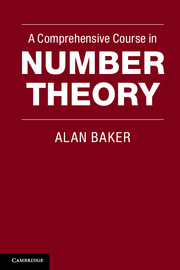Book contents
- Frontmatter
- Contents
- Preface
- Introduction
- 1 Divisibility
- 2 Arithmetical functions
- 3 Congruences
- 4 Quadratic residues
- 5 Quadratic forms
- 6 Diophantine approximation
- 7 Quadratic fields
- 8 Diophantine equations
- 9 Factorization and primality testing
- 10 Number fields
- 11 Ideals
- 12 Units and ideal classes
- 13 Analytic number theory
- 14 On the zeros of the zeta-function
- 15 On the distribution of the primes
- 16 The sieve and circle methods
- 17 Elliptic curves
- Bibliography
- Index
12 - Units and ideal classes
Published online by Cambridge University Press: 05 November 2012
- Frontmatter
- Contents
- Preface
- Introduction
- 1 Divisibility
- 2 Arithmetical functions
- 3 Congruences
- 4 Quadratic residues
- 5 Quadratic forms
- 6 Diophantine approximation
- 7 Quadratic fields
- 8 Diophantine equations
- 9 Factorization and primality testing
- 10 Number fields
- 11 Ideals
- 12 Units and ideal classes
- 13 Analytic number theory
- 14 On the zeros of the zeta-function
- 15 On the distribution of the primes
- 16 The sieve and circle methods
- 17 Elliptic curves
- Bibliography
- Index
Summary
Units
An algebraic integer ε is said to be a unit if 1/ε is an algebraic integer. This…is equivalent to the condition Nε = ± 1. Indeed the conjugates of an algebraic integer are again algebraic integers, whence, if ε is a unit, then Nε and 1/Nε are rational integers and so ±1. Conversely if Nε = ±1 then 1/ε = ±Nε/ε which is clearly an algebraic integer. The set of all units form a group U under multiplication and the set of units in a number field K form a subgroup UK. Further, we see that if [α], [β] are principal ideals in K then we have [α] = [β] if and only if α/β ∈ UK. In general, we say that non-zero algebraic numbers α, β are associated if α/β ∈ U.
The units in ℚ are plainly ±1 whence they are all the roots of unity in ℚ, that is, the solutions of an equation xl = 1 for some positive integer l. The units of the quadratic field K = ℚ(√d), where d ≠ 1 is a square-free integer, were discussed in Section 7.3. It was shown there that for the imaginary quadratic field K with d < 0 the units are again all the roots of unity in the field; they are given by the zeros of x2 − 1 for D < −4, of x4 − 1 for D = −4 and of x6 − 1 for D = −3 where D denotes the discriminant of the field, that is, D = 4d for d ≡ 2, 3 (mod4) and D = d for d ≡ 1 (mod4).
- Type
- Chapter
- Information
- A Comprehensive Course in Number Theory , pp. 122 - 146Publisher: Cambridge University PressPrint publication year: 2012



